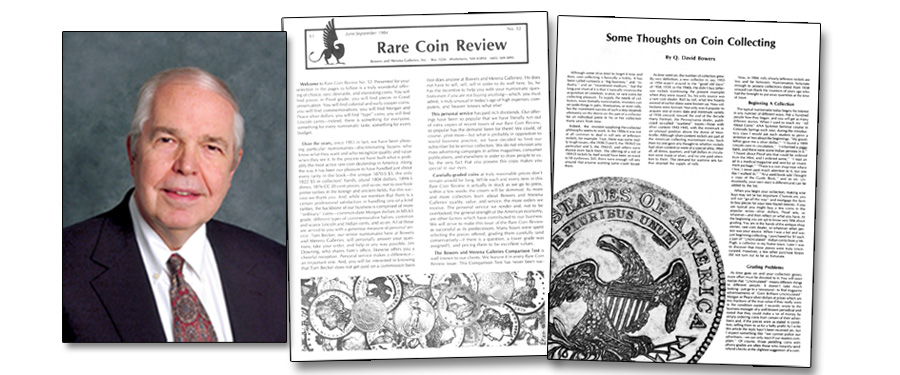
From Rare Coin Review #52, June-September 1984
Over the years I have written numerous articles in various publications with my take on the “world’s greatest hobby” and encouraging readers to enjoy coins as much as I do. In fact, my weekly column in Coin World is titled “The Joys of Collecting.” In Rare Coin Review #52 from 1984, I found a typical QDB article, somewhat blandly titled “Some Thoughts on Coin Collecting.” Some parts of the article, especially the sections on grading, coin storage and research, are not so applicable today. However, the section headlined “Fun With Coins” is just as valid today as it was 30 years ago. I reprint that section here:
Fun With Coins
Once you own a coin, take time to enjoy it. I mean this seriously. Too often someone will hunger after a coin—whether it be a 1939-D Uncirculated Jefferson nickel or an 1879 $4 Stella, and then, upon acquiring it, scarcely take time to appreciate it. Take out a magnifying glass, hold the coin carefully, and study all the design details. A coin does not have to be rare or expensive to provide fascination. I bet that a nice Extremely Fine Capped Bust half dollar, a piece worth in the $100 range [in 2014 worth more, but still relatively inexpensive], can provide at least five to ten minutes worth of study, for example. Take a coin—any coin (but it helps if it is older, for older pieces have more interesting characteristics)—and study it under magnification. If the piece is dated prior to about 1836, chances are good that it will have many fascinating idiosyncrasies. Look at the numerals of the date. Some are probably spaced differently than others with respect to the surrounding digits. Look at the letters in the legend. Some may be recut, if only minutely. Where is the initial of the engraver (not found on very early pieces, but a feature of coins from the mid-nineteenth century onward)? Once you found it, what do you know about him [or her]? How long did he work at the mint? What are some of the other coins he designed? Are there any die breaks on the coin? If so, what route do they take across the surface of the piece you are examining?
Why was the coin issued? How many were minted? How rare is the issue in different states of preservation? If it is worn, is this unusual? What areas of the design show the most wear? What was the use of such a coin in everyday commerce—can you relate it to history, banking or some other aspect? In what metal was the coin struck? How pure is the metal or what is the alloy? Consider the date and denomination of the coin, then refer to a reference book to find out what other denominations were made the same year—and how many were made of each, and of what metals were they struck, and who designed them, and what uses did they have in the channels of commerce?
Is the edge of the coin plain? If so, study it carefully for marks. Are there vertical streaks (from ejection from a collar), or was it struck without a collar (such was the case with early copper coins)? Is the edge lettered? If so, what is the design? What about the rim? Is it narrow or wide? Is it the same width in all areas, or does it vary? How does the obverse rim compare to the reverse rim? What about the treatment right inside the rim? Are there denticles (tiny toothed projections)? If so, are the denticles evenly spaced or are they irregular? Or are there beads? Or, perhaps, the field curves directly up to the rim without any ornamentation. What is the style of the letters? Are they fancy (with serifs) or are they plain? What about the central design? Are the features sharp in all areas (on early coins they usually are not)? What else can you notice?
Just as a tennis player endeavors to develop a “personal relationship” with the ball, the numismatist would do well to develop a personal relationship with the coins he owns. Coins are attractive, they have personalities, and they are willing to more than repay any interest paid to them. Don’t ignore your coins, study them carefully; appreciate them. Of course, in the process you are gaining knowledge—and, knowledge is everything.





